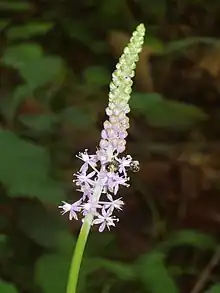Barnardia
Barnardia is a small genus of bulbous flowering plants in the family Asparagaceae, subfamily Scilloideae (also treated as the family Hyacinthaceae).[2] The genus has two species, one found in the Balearic Islands and north-west Africa, the other in east China, Korea, Japan and adjacent localities.[1] It was suggested in 2012 that the two species were not closely related.[3]
| Barnardia | |
|---|---|
 | |
| Barnardia japonica | |
| Scientific classification | |
| Kingdom: | Plantae |
| Clade: | Tracheophytes |
| Clade: | Angiosperms |
| Clade: | Monocots |
| Order: | Asparagales |
| Family: | Asparagaceae |
| Subfamily: | Scilloideae |
| Genus: | Barnardia Lindl.[1] |
Description
Plants of Barnardia grow from bulbs. The flowers appear in the autumn and are borne in a dense raceme containing small narrow bracts. Individual flowers are star-shaped, small, and with pink or more rarely white tepals. The filaments of the stamens are widened at the base. The elongated seeds are dark brown in colour.[4]
Systematics
The genus Barnardia was created by John Lindley in 1826 together with the single species B. scilloides. However, this species had already been described as Ornithogalum japonicum by Carl Peter Thunberg in 1784, so that it is now called B. japonica.[1] The genus name honours Edward Barnard.[5]
Barnardia is placed in the tribe Hyacintheae, subtribe Hyacinthinae (or the subfamily Hyacinthoideae, tribe Hyacintheae, by those who accept the family Hyacinthaceae). The genus (represented by B. japonica) occupied a basal position in the Hyacinthinae in a 1999 molecular phylogenetic analysis, suggesting an early evolutionary origin.[6]
Species
As of March 2013, the World Checklist of Selected Plant Families recognized two species:[7]
- Barnardia japonica (Thunb.) Schult. & Schult.f. (syns Ornithogalum japonicum Thunb.; B. scilloides Lindl., B. sinensis (Lour.) Speta; Scilla chinensis Benth., nom. illeg., S. japonica Baker, nom. illeg., S. sinensis (Lour.) Merr, S. scilloides (Lindl.) Druce)
- From eastern Asia (China, Japan, Korea, Taiwan, and Russia around Vladivostok)
- Barnardia numidica (Poir.) Speta (syns Scilla numidica Poir., S. parviflora Desf., nom. illeg.)
- From the Balearic Islands and north-west Africa (Algeria, Tunisia, Libya)
Ali et al. (2012) suggest that B. numidica is not related to B. japonica and should be transferred to a genus of its own.[3]
Cultivation
Barnardia japonica is cultivated as an ornamental bulb, sometimes under one of its synonyms, such as Scilla scilloides. In a temperate climate it requires a sunny position where it flowers in the autumn. As well as the normal pink-flowered form, a white form is in cultivation.[8]
References
- "Barnardia", World Checklist of Selected Plant Families, Royal Botanic Gardens, Kew, retrieved 2013-03-28
- Stevens, P.F. (2001 onwards), "Asparagales: Scilloideae", Angiosperm Phylogeny Website, retrieved 2013-03-28
- Ali, Syed Shujait; Yu, Yan; Pfosser, Martin & Wetschnig, Wolfgang Wetschnig (2012), "Inferences of biogeographical histories within subfamily Hyacinthoideae using S-DIVA and Bayesian binary MCMC analysis implemented in RASP (Reconstruct Ancestral State in Phylogenies)", Annals of Botany, 109 (1): 95–107, doi:10.1093/aob/mcr274, PMC 3241591, PMID 22039008, p. 101
- "Barnardia Lindl". eMonocot. Archived from the original on 2013-04-19. Retrieved 2013-03-28.
- Lindley, J. (1826), "Barnardia scilloides", The Botanical Register, 12: plate 1029, retrieved 2013-04-17
- Pfosser, Martin; Speta, Franz (1999). "Phylogenetics of Hyacinthaceae based on plastid DNA sequences" (PDF). Annals of the Missouri Botanical Garden. 86 (4): 852–875. doi:10.2307/2666172. JSTOR 2666172.
- Search for "Barnardia", World Checklist of Selected Plant Families, Royal Botanic Gardens, Kew, retrieved 2013-03-28
- Beckett, K., ed. (1994), Encyclopaedia of Alpines : Volume 2 (L–Z), Pershore, UK: AGS Publications, ISBN 978-0-900048-62-3, p. 1203